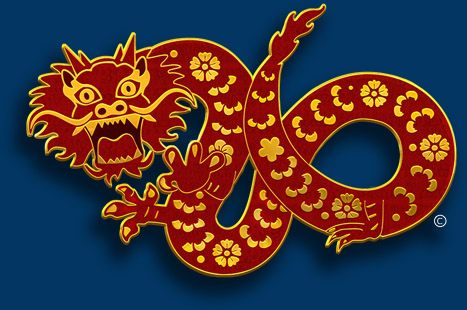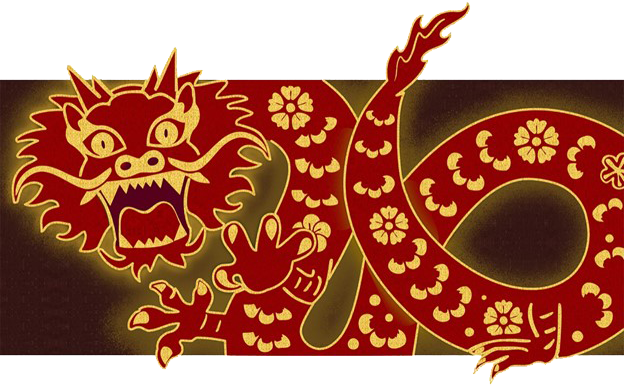
DVD
In Our E-Store
Sifu Liu's Feeding Crane
Combat Applications & Kata
Finding Thunder: Exploring The White Crane Kung Fu of Liu Chang I – Part 1
By Christopher Caile
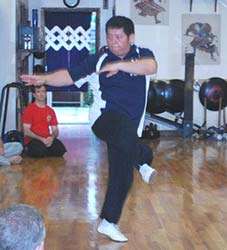 |
|---|
Sifu Liu Chang I demonstrates a Feeding Crane kata. |
It started with an e-mail from my first karate teacher, Hanshi Phil Koepple (founder of the US Karate Do Kai).
"Christopher: Over the last 3 years I have had the opportunity to host Sifu Liu Chang I…third generation Feeding Crane (a style of White Crane Kung Fu) Master. Chris, he is something else. .. strong, fast and with tremendous internal strength. .. and willing to teach anyone willing to learn his family Feeding Crane concepts which are an important influence on Okinawan karate….You might be interested in meeting him and writing an article for … FightingArts.com I have told him of you and one of his representatives should be getting in contact."
Koepple's e-mail also contained a mysterious reference, that Sifu Liu's technique also produced "thunder." "What's that?," I said to myself. I had never heard the term. So I was interested.
I was aware too that White Crane had influenced the development of Goju Ryu Karate as well as several Shorin Ryu styles (including Hohan Soken heritage). (1) Having some experience in these arts I thought it would be interesting to see the similarities of technique, strategy and power generation with that of Feeding Crane. These I point out in the article, but leave greater detail to the footnotes.
Several weeks later I attended a weekend long seminar on Feeding Crane. I also was able to talk at length with Sifu and interview him and several of his students.
History of Feeding Crane (Bai He Men Shi He Quan)
Sifu Liu Chang I is the lineage head of the Liu family Feeding Crane passed on from his grandfather to his father to him. The art was introduced to Taiwan and his grandfather in the early part of the 20th Century from Fuchow, China where it had already developed through nine generations of head masters. Today it is practiced unchanged from how it was taught within the Liu family. Feeding Crane is part of the Crane family, sharing lineage with Bai He (White Crane), Ming He (Singing Crane), and Wing Chun, among others.
Feeding Crane (White Crane) As A Fighting Art
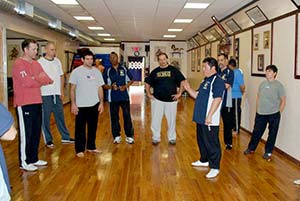 |
|---|
Sifu Liu talks to his seminar participants. |
Feeding Crane is not showy. If you are looking for low, deep stances, spectacular high kicks and gymnastics, this is not your art. But what Feeding Crane lacks in grace it makes up for in brutal efficiency. It is also unique. It is a time capsule of old fighting technique — technique tested in combat and passed on to us over 12 generations through turbulent times. It is not always as pretty as Wushu (modern Chinese martial arts) but its techniques are very applicable to both self defense and street situations. Weapons are not included within the curriculum. Feeding Crane as taught by Sifu Liu contains only empty hand self-defense technique.
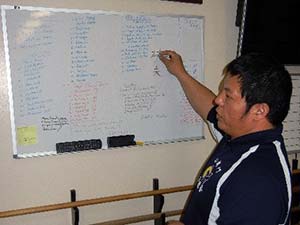 |
|---|
Sifu Liu explains the meaning of the Chinese characters used for "Kung Fu", "Chi Kung" and other terms. |
Of all the Chinese martial arts I have seen, or studied, Feeding Crane seems the closest to old style Okinawan karate. It represents a link to the past, to Okinawan self-defense before modern karate, before styles and sport karate.
Power Generation
As for Sifu Liu's "thunder." You can hear it in his body — a sort of "kaplunk" sound that shadowed Sifu Liu's hand and arm techniques. It is part of what Sifu Liu calls "Short Power" (within the shoulders and arms). It is also one of the defining aspect of Sifu Liu's Feeding Crane.
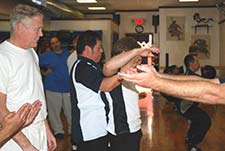
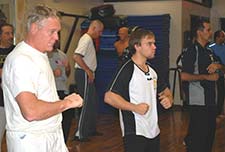
Students practice shoulder and arm exercises designed to build "Short Power." They are simple and easy to learn, but take practice.
Where the "thunder" comes from I am not sure, but my guess is that it is the result of muscles suddenly contracting over a short distance, then relaxing again at such intensity that the muscle mass ricochets out and then back into a relaxed state. The sharp contraction of the muscles in the chest also make a sort of drum out of the chest cavity, together creating a very pronounced sound. I have never heard before. When developed it signifies generation of tremendous power in a space of only inches.
This same "thunder" was reputedly also exhibited by Chojun Miyagi (founder of Goju-Ryu karate) and other Okinawan karate masters of the past. It is perhaps another component of old Okinawan karate lost to modern exponents of the art. Michael Calandra, a New York area senior Isshin-Ryu Karate teacher told me that his teachers had talked about Tatsuo Shimabuku's (their teacher and the styles founder) short range power. "To me, seeing Feeding Crane, " Calandra said, "is a confirmation of my own karate heritage. It also tells me that I am on the right path."
Another components of Feeding Crane power and energy come from the use of body mass, such as moving forward, dropping weight or rising up behind a technique. The "rise, sink, spit, swallow" ideas common to Goju Ryu and a variety of southern Chinese systems. More important and also central to Feeding Crane, however, is "Shaking Power" – a back and forth, short twitching movement of the hips, lower abdomen and upper thighs. It can generate short waves of energy upward through the abdomen to the shoulders and arms. This is a powerful mix.
This type of power generation was once used by many early Okinawan karate masters (an internal type power) but over time it has been largely lost to modern practitioners. "Shaking Power" is very different from power generation now used in most modern Japanese karate, boxing and Muay Thai (Thai boxing using low kicks and knees). (2) But some on Okinawa and elsewhere still cling to the older ways of power generation similar to Feeding Crane's "Shaking Power," adding too their own variants. Examples include old forms Shorin-Ryu karate, including Kishaba Juku Shorin-Ryu Karate and Hohan Soken's White Crane karate lineage and others. There are also others within Goju-Ryu and other Okinawan karate groups. (3)
Commenting on the importance of power, Sifu Liu says: "Power is just as important as kata. Without it you can't make (kata) applications work. But it takes time to develop it, especially 'thunder' power. It can take years, but the biggest step is the first one per cent because it indicates your body is starting to learn how to create it. Also power is not just brute force. It also includes yielding and 'shaking' power."
Body Conditioning
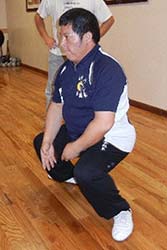 |
|---|
Sifu Liu demonstrates another "Short Power" development exercise. This one starts from a deep horse stance that also helps condition the legs. |
Feeding Crane stresses body conditioning, especially of the lower body. "It's an important part of training," says Sifu Liu. "In the old days on Taiwan people walked to get around, often along paths in the hills where you were vulnerable to attack and robbery. So the way of self-defense was within you. We had no guns. You learned to harden your body against attack and make yourself strong."
Conditioning the body and legs in Feeding Crane is a process of body adjustment. Slapping and progressive harder hitting gradually harden the body. Deep horse stances are also used. So are low shin round kicks to a partner's legs and thighs. "These exercises should hurt a little," says Sifu Liu, "but not too much. A lot of pain is too much, but without some pain you get nothing."
Slapping and body hitting are also found in Goju-Ryu's (and other karate styles) sanchin kata testing (shime) — the kata designed to build proper body alignment, technique, power and stamina. Similar techniques are also part of hard Chi Kung (Qigong) — used in many Chinese martial arts to develop a type of internal energy (chi or qi) to fortify the body against attack.
Read more about Feeding Crane, its technique, body control and practice in part 2 of this article.
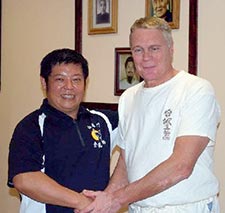
Feeding Crane master, Sifu Liu Chang'I and Christopher Caile, founder and editor of FightingArts.com
Footnotes:
1- Many Uechi Ryu karate techniques also resembled those in White Crane. White Crane Kung Fu influenced the evolution of Miyagi's Goju Ryu karate. Miyagi also practiced with a White Crane exponent, Go Kenki, after the death of his primary teacher, Higaonna, in 1915. White Crane technique and kata were also an integral part of the karate taught by Hohan Soken sensei. See footnote 4.
2- These arts use a type of circular, external generated power driven from the legs, up through the rotated hips, abdomen, and shoulders, each segment rotated as a whole to extend power and speed to target. Various karate books often depicting each segment as a fixed rotational whole. The method can be powerful, but is very different from methods as used in Feeding Crane that utilize fluid movements within body segments to produce a whipping power.
3- Soken was a great Okinawan karate master who taught White Crane as part of his karate and who also exhibited a type of "Shaking Power." I see it in his students, including my aikido teacher, Roy Suenaka Sensei, who still teaches Soken's karate (Seito Matsumura Shorin-Ryu) in Charleston, SC. Soken traced his White Crane heritage back through his uncle to Bushi Matsumura (a diplomat and body guard to the king of Okinawa) who was a well spring of much of modern Shorin-Ryu karate. If this lineage is correct much of Shorin-Ryu karate was at least influenced by White Crane. Other Shorin-Ryu masters also exhibited similar "Shaking Power," especially, among masters from Tomari (an Okinawan seaport near the old capital). One such person is Siegi Nakamura a senior teacher from Tomari who taught in Shoshin Nagamine's Matsubayashi headquarters dojo on Okinawa. He also trained with Hohan Soken.
See footnote 3. Kishaba Juku Shorin-Ryu Karate on Okinawa have attempted to develop the old ways of body dynamics into a teaching curriculum. Other's from Okinawa also use this power method including some Goju-Ryu exponents associated with the Jundokan organizations. My research also suggests that Kenwa Mabuni (founder of Shito-Ryu and early pinoneer of Japanese karate) also ulitized this type of power generation.

About the Author Christopher Caile
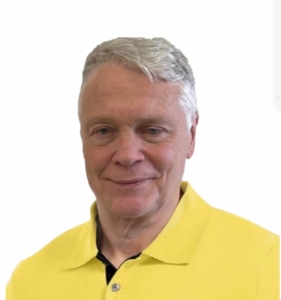
Screenshot
Christopher Caile is the Founder and Editor-In-Chief of FightingArts.com. He has been a student of the martial arts for over 65 years.
He first started in judo while in college. Then he added karate as a student of Phil Koeppel in 1959 studying Kempo and Wado-Ryu karate. He later added Shotokan Karate where he was promoted to brown belt and taught beginner classes. In 1960 while living in Finland, Caile introduced karate to that country and placed fourth in that nation's first national judo tournament.
Wanting to further his karate studies, Caile then hitch hiked from Finland to Japan traveling through Scandinavia, Europe, North Africa, the Middle East and South and Southeast Asia — living on 25 cents a day and often sleeping outside.
Arriving in Japan (1962), Caile was introduced to Mas Oyama and his fledgling full contact Kyokushinkai Karate by Donn Draeger, the famous martial artist and historian. Donn also housed him with several other senior international judo practitioners. Donn became Caile's martial arts mentor, coaching him in judo and introducing him to Shinto Muso-ryu under Takaji Shimizu.
Caile studied at Oyama's honbu dojo and also at Kenji Kurosaki's second Tokyo Kyokushinkai dojo. In his first day in class Oyama asked Caile to teach English to his chief instructor, Tadashi Nakamura. They have been friends ever since. Caile also participated in Oyama's masterwork book, "This Is Karate."
Caile left Japan with his black belt and designation as Branch Chief, the first in the US to have had extensive training in Japan directly under Oyama Sensei. As such, Oyama Sensei asked him to be his representative on visits to his US dojos to report on their status.
A little over a year later, Nakamura, Kusosaki and Akio Fujihira won an epic David vs. Goliath challenge match against Thailand's professional Muay Thai Boxers in Bangkok, Thailand, thrusting Kyolushinkai and Nakamura into national prominence.
Back in the US Caile taught Kyokushinkai karate in Peoria, Il while in college and later in Washington, DC. while in graduate school. Durimg this time Shihan Nakamura had moved to New York City to head Kyokushinkai's North American Operation.
In 1976 when Kaicho Tadashi Nakamura formed the World Seido Karate organization, Caile followed. Living then in Buffalo, NY, Caile taught Seido karate and self-defense at the State University of New York at Buffalo (SUNY Buffalo) for over 15 years where he also frequently lectured on martial arts and Zen in courses on Japanese culture.
Caile moved to New York City in 1999 to marry Jackie Veit. He is now an 8th degree black belt, Hanshi, training in Seido Karate's Westchester, NY Johshin Honzan (Spiritual Center) dojo. In Seido Caile is known for his teaching of and seminars on kata applications. He also produced a 14 segment video series on Pinan kata Bunkai currently available to Seido members.
Caile is also a long-time student and Shihan in Aikido. He studied in Buffalo, under Mike Hawley Shihan, and then under Wadokai Aikido's founder, the late Roy Suenaka (uchi deshi under Morihei Ueshiba, founder of Aikido and was Shihan under Tohei Sensei). In karate, Suenaka (8thdan) was also an in-house student of the Okinawan karate master Hohan Soken.
Having moved to New York City, Caile in 2000 founded this martial arts educational website, FightingArts.com. Twenty-five years later, in 2025, it underwent a major update and revision.
For FightingArts.com and other publications Caile wrote hundreds of articles on karate, martial arts, Japanese art, Chinese Medicine and edited a book on Zen. He also developed relationships with a cross section of leading martial arts teachers. Over the last four decades he has conducted extensive private research into karate and martial arts including private translations of the once secret Okinawan hand copied and passed on Kung Fu book, the Bubishi, as well as an early karate book by the karate master Kenwa Mabuni. He periodically returns to Japan and Okinawa to continue his studies and participate Seido karate events. In Tokyo he practiced (with Roy Suenaka Sensei) in a variety of aikido organizations with their founders – including private interviews and practices at the Aiki-kai Aikido Honbu dojo with the son and grandson of aikido's founder, Doshu (headmaster) Kisshomaru (an old uchi-deshi friend) and his son, Moriteru Ueshiba and in Iwama with Morihiro Saito. On Okinawa he studied Goju Ryu karate under Eiichi Miyazato, 10th dan founder of Naha's Jundokan, and also with Yoshitaka Taira (who later formed his own organization, who specialized in kata Bunkai. While there Caile also trained with Hohan Soken's senior student, Master Fusei Kise, 10 dan as well as with the grandson of the legendary karate master Anko Itosu.
Caile's other martial arts experience includes: Diato-ryu Aikijujitsu and Kenjitsu, kobudo, boxing, Muay Thai, MMA, Kali (empty hand, knife and bolo), study of old Okinawan Shoran-ryu & Tomari body mechanics, study of old Okinawan kata under Richard Kim, study of close quarter defense and combat, including knife and gun defenses, Kyusho Jitsu and several Chinese fighting arts including 8 Star Praying Mantis, Pak Mei (White Eyebrow), and a private family system of Kung Fu.
Caile is also a student of Zen as well as a long-term student of one branch of Traditional Chinese Medicine, Chi Kung (Qigong). As one of two senior disciples of Chi Kung master Dr. Shen (M.D., Ph.D.) Caile was certified to teach and practice. This led to Caile's founding of the The Chi Kung Healing Institute on Grand Island, NY. In Western NY, he also frequently held Chi Kung seminars, including at SUNY Buffalo and at the famous Chautauqua Institution in Chautauqua, NY. His articles on Chi Kung also appeared in the Holistic Health Journal and in several books on alternative medicine.
Caile holds a BA in International Studies from Bradley University and MA in International Relations with a specialty in South and Southeast Asia from American University in Washington, D.C. While in Buffalo, NY he also studied digital and analog electronics.
In his professional life Caile also worked in public relations and as a newspaper reporter and photographer. Earlier he worked in the field of telecommunications including Managing a Buffalo, NY sales and service branch for ITT. He then founded his own private telephone company. This was followed by creation of an electrical engineering company that designed and patented his concept for a new type of low-cost small business telephone system (which was eventually sold to Bell South). The company also did contract work for Kodak and the US space program. Simultaneously Caile designed and manufactured a unique break-apart portable pontoon boat.
Most recently Caile co-founded an internet software company. Its products include software suites with AI capability for control and management of streaming media, such as video and music, an all-in-one book publishing software product for hardcover, eBook and audio book creation and security software for buildings and government use.
For more details about Christopher Caile's martial arts, work experience and life profile, see the About section in the footer of this site.
Search for more articles by this author:

